Mount Holyoke’s Makerspace Encourages Culture of Creativity
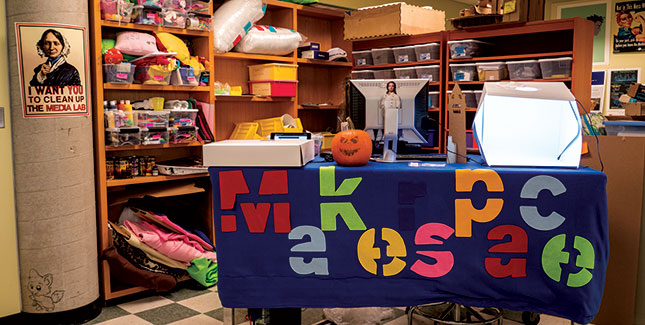
The College’s current Makerspace, in Room 211 of the Art Building, inspires creativity and innovation and offers resources to support novices and experts alike as they turn their ideas into reality. Photo by James Gehrt
As a teenager in middle school in India, Michelle (Misha) Ali ’17 remembers listening to music with her friends and saying things like “Wow, this song is so purple.”
Her friends would laugh, and at first she thought it was because they were seeing different colors. Only later did she realize that the vibrant auras lighting up the periphery of her vision were unique to her experience.
“I read this book called The Tell-Tale Brain by V.S. Ramachandran,” Ali says, “and there’s a section in the book where he talks about synesthesia. As I was reading it, I was like wait, wait, wait, he’s talking about this as if it were a case study. I thought this was how everyone perceived the world.”
It wasn’t until she encountered the Makerspace at Mount Holyoke that Ali found a way to bridge that gap in perception—to share with others a simulacrum of what she sees when she hears music. At a workshop with Makerspace Coordinator Shani Mensing ’15, Ali casually mentioned an idea she had for an electronic device that would light up in different colors depending on the audio input it was receiving—or the music it was “hearing”—to simulate the experience of synesthesia.
Mensing was intrigued. She asked Ali to describe the concept in an email and shared the idea with Luke Jaeger, technical project administrator in the computer science department. Soon Ali had a team behind her, a micro-grant, and, eventually, an award-winning entry in Hampshire College’s February 2016 hackathon. That November, a more advanced version of her machine—called MuSyC for Music-Synesthesia-Color—was a finalist at the Tech Expo at MIT Media Lab’s Hacking Arts Conference.
“Without the Makerspace, and the encouragement from people there and the resources available there,” Ali says, “I honestly would not have even pursued these projects or even thought that I could pursue these projects.”
Now a research associate at the brain and cognitive science department at MIT, Ali—whose MuSyC device continues to evolve—understands the power of such transformations.
“At Mount Holyoke,” she says, “people are encouraged to branch out. And that I think is really valuable for people who may not necessarily have thought that they could do any kind of engineering and they’re like ‘oh wait, wow, I can actually do this?’ There were definitely times when I was really frustrated with my MuSyC project or things didn’t work and I would go to Shani, or go and sit with Luke, or talk to [Associate Professor of Computer Science] Audrey St. John, and I would come out of the Makerspace feeling like hey, whatever I want to do, I can do it. I can make anything. That reassurance is incredibly valuable.”
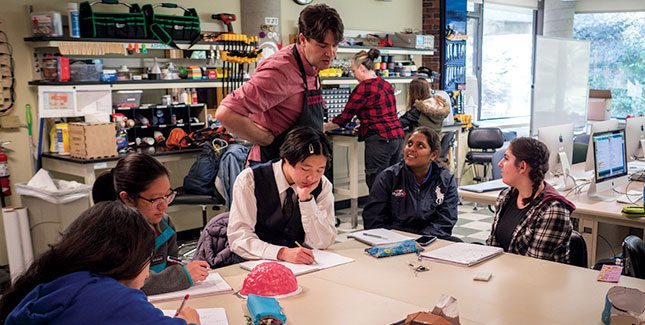
In addition to supporting individuals and class projects, staff at the Makerspace conduct workshops on topics including wearable technology, robot building, paper models, and even Halloween costume making. Photo by James Gehrt
For Mensing, creating the conditions for students to pursue ideas big and small is at the heart of the Makerspace and of a broader “maker” culture on campus.
“Makerspaces are great—and making in turn is so great,” Mensing says, “because you’re actually doing something hands on, you’re creating something from nothing, and you’re able to see a result immediately. Going from adding code and then seeing something light up and knowing that you were able to do that really is a very transformative experience. And what’s nice about actual hands-on experiences is that they really demystify technology. It’s ‘I did this myself’ rather than having something just handed to you. That experience creates a sense of empowerment.”
Makerspace faculty lead Katherine Aidala, a professor of physics who also chairs the physics and engineering departments at Mount Holyoke, agrees.
“We’re thinking about the Makerspace and the maker culture as having multiple levels of engagement,” she says. “We regularly do creative circuit workshops, wearable circuit workshops, arduino micro-controller workshops—that sort of get students’ feet wet. It’s very powerful because it’s exposing students to these ideas in a context that’s relevant to them. If we infuse the entire four years at Mount Holyoke with maker experiences, we end up expanding people’s worlds.”
The room where Mensing and Aidala facilitate such learning, Art 211, is a kind of hub for maker culture on campus. It houses an array of equipment including a laser cutter, a vacuum former, two 3-D printers, sewing machines, soldering tools, and computers. Prior projects, including a leather bear and a wooden engraving of an Eduardo Galeano poem, line the walls, and student workers move busily through the room, helping their peers find what they need, teaching them how to operate the equipment, and brainstorming with them to generate ideas for projects.
Jennifer Ann Lamy ’18 started working in the media lab when she was a sophomore and watched as it transitioned into the Makerspace. That spring, she says, she saw interest in the new campus resource begin to take hold.
“It was interesting to see a flow of students from lots of different departments coming in to work on different projects,” she says. “I think everyone within them has a little maker. Because there’s always something that you want to make. And you don’t necessarily have the equipment or the materials to do that, whereas when you come here you have all of that available to you. Which is the nicest thing.”
An architecture major, Lamy has used the space for her own academic work and loves the creative possibilities it affords. In the Makerspace, she says, she can “just go crazy with my projects because I know that I don’t need to sit there and cut everything by myself, so I can get a little more creative.” She is currently working on mapping the effects of forces such as sound, car traffic, and pedestrian movement on a park in Sapporo, Japan, using the laser cutter to make intricate cuts indicating direction and force as part of the site analysis.
Lamy’s co-worker in the Makerspace, sophomore Katie Kelso, was drawn to the space by the workshops offered around particular holidays—costume design for Halloween, for example, and making molded chocolates for Valentine’s Day. She loved those experiences and wanted to do more. Last fall, she used her skills to help design a prop incorporating neopixel strips into fabric to illuminate the electrical vivification of Frankenstein’s monster in an October production at the Rooke Theatre of Mary Shelley’s classic novel.
“I’m a theatre major, and I do lights,” Kelso says. “So this is nice because it’s a new way of lighting the stage. It’s not just from above or having a big lighting unit on stage. Now you can do little things here and there that really help make the show pop.”
Such integrations of art and technology are the motivating force behind a recent $500,000 grant from the Sherman Fairchild Foundation that launched the College’s MEDIAL Project. “MEDIAL” stands for “MHC Empowering Discovery, Innovation, and Artistic Learning.”
The grant will be applied largely to upgrading media and film production and audio and sound production facilities, including a new digital music lab. There are also plans for substantial upgrades to the Makerspace.
“This grant is a wonderful illustration of the liberal arts in the twenty-first century,” says Jon Western, vice president for academic affairs and dean of faculty, who notes that making, experiencing, and teaching art in the twenty-first century is increasingly technological and collaborative.
The funds support expanding artistic spaces where students can create, exhibit, and perform art that incorporates a mix of disciplines and technologies, as well as creating new courses and reformulating existing ones. The improvements are aimed at elevating and sustaining a powerful maker culture at Mount Holyoke—one of the most important goals in The Plan for Mount Holyoke 2021, the College’s strategic plan—and helping to transform teaching and learning across the curriculum.
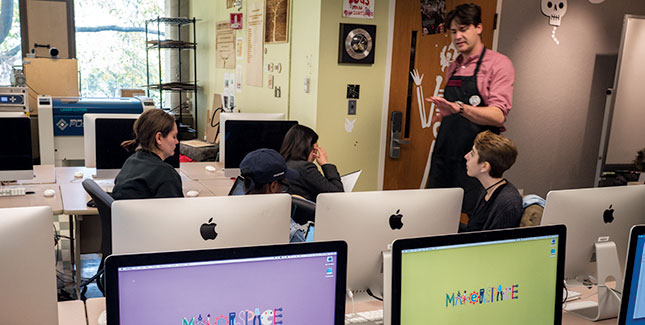
Assistant Professor of Computer Scienve Peter Klemperer talks to students in the Makerspace. Photo by James Gehrt
Like many of his colleagues, Western has already found opportunities for such innovations in his own classes. The Carol Hoffmann Collins ’63 Professor of International Relations teaches the course American Foreign Policy, and during a unit about the use, power, and ethics of drone technology, he took his students to the Makerspace to build drone rovers and then simulated a humanitarian-relief mission in Kendade Atrium—at lunchtime.
“I gave the students incentives to compete against each other, and we put teams together. We put the rovers on one end of the atrium, and they had to get across,” Western says. “But we did it during a time when there was an interface of students in that space that we couldn’t control. So those students were picking up the drones and looking around, trying to figure out who was running them. And my students were trying to get the task done.”
As a result, Western says, his students experienced some of the things that drone operators in the real world might experience—engaging with technology while that technology is engaging with humans outside of the operators’ control. The next step, he says, was to take that experience back into the classroom and for students to consider how they thought about the technology and how they thought about “the inability to control the environment around which they were trying to engage with the technology.” And then, Western says, “thinking through the questions of the moral and political and social implications of all of this.”
To further promote such learning, the College has recently made several “innovation hires,” a new category of teaching position that invites candidates to join the faculty community to shape innovative directions in curriculum. One such hire, Peter Klemperer, is both an assistant professor in computer science and an innovation hire in engineering, which means that he teaches hands-on classes with few or no prerequisites, such as robotics, iDesign Studio, and, beginning next semester, a course called Engineering for Everyone.

Students in Jon Western’s American Foreign Policy class designed and built drone rovers in the Makerspace and used them to simulate a humanitarian-relief mission. Photo by Nick Baker
A lifelong tinkerer whose earliest projects included building skateboard ramps for himself and his friends in his native Illinois, Klemperer has lived the “do it yourself” philosophy that comes with maker culture, and he believes that imparting it to students can have a real impact.
“What we’re looking for,” he says, “is for students to have that transformative experience where they start out thinking this isn’t for me, people have told me this isn’t for me, I haven’t had good experiences with this. And then, in a very low-stakes, high-support environment, they get to reshape who they think they are.”
Klemperer describes discussions in the Makerspace where students talk about challenges as much as successes and the ways such conversations build trust and create an environment where being a beginner feels like a safe and shared experience.
Then, he says, “you get to solve all sorts of problems, you get to make cool things, you get to make an impact on the world beyond what you thought you could before. That’s really what I’m excited about when I teach in that space.”
—By Abe Loomis
Abe Loomis is a freelance writer based in western Massachusetts. Contact him at abe.loomis@gmail.com.
This article appeared as “In the Making” in the winter 2018 issue of the Alumnae Quarterly.
January 11, 2018




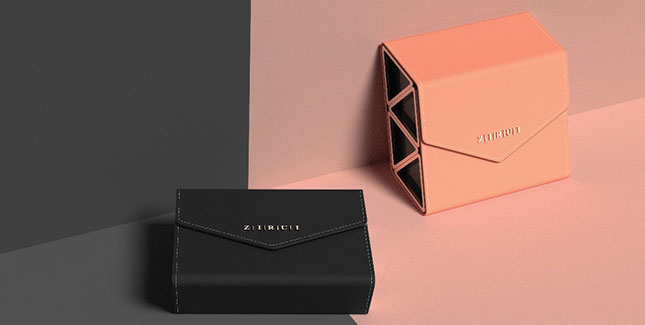





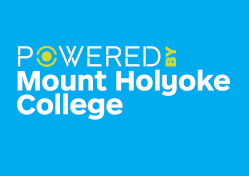

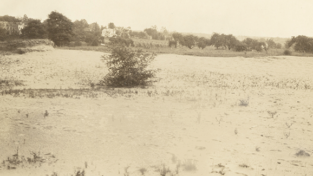
After 35 years traveling the globe as a travel writer and photographer, I retired (if writers ever retire) and found myself with time on my hands. At 82 and with disabling arthritis, there was just so much I could do to fill the time. Then, for no definable reason, I began to make things with beads–bracelet, earrings and necklaces. My creative juices revived, and my office became filled with boxes of semiprecious rounds, bone bead from Africa, and silver, brass and gold “findings.”
I love the idea of a Makerspace at Holyoke. As a student in the 1950s, I would have enjoyed working on ideas there both as a creative outlet and as a release from the stress of studies. Kudos to the school for realizing this need and acting on it.
Just as this 82-year-old is lamenting the fact that there was no Makerspace in the 1950’s, I ,too, would have enjoyed the Makerspace in the 1970’s! I was intrigued by the story of Ms. Rowland from the class of 1847 who invented the American Valentines. Even she in the 19th century could have benefitted from the Makerspace. I am so happy to hear of this place on campus for the students to be creative. Keep up the good work making meaningful additions to MHC.